

Vertebrata Palasiatica ›› 2025, Vol. 63 ›› Issue (2): 81-101.DOI: 10.19615/j.cnki.2096-9899.250331
LIU Lu1, REN Ji-Cheng2,3, MAO Fang-Yuan2,*( )
)
Received:2025-02-27
Online:2025-04-20
Published:2025-04-25
Contact:
*maofangyuan@ivpp.ac.cnAbout author:First author contact:Liu Lu and Ren Ji-Cheng contributed equally to this work and share the first authorship
基金资助:CLC Number:
LIU Lu, REN Ji-Cheng, MAO Fang-Yuan. Reinvestigation of Yuanotherium minor and its implications for the cuspal homology and maxillary-palatal evolution of tritylodontids. Vertebrata Palasiatica, 2025, 63(2): 81-101.
刘璐, 任纪澄, 毛方园. 2025, 63(2): 81-101, 小袁氏兽的再研究及三列齿兽齿尖同源性和上颌-腭部演化的探讨. 古脊椎动物学报.
Add to citation manager EndNote|Ris|BibTeX
URL: https://www.vertpala.ac.cn/EN/10.19615/j.cnki.2096-9899.250331
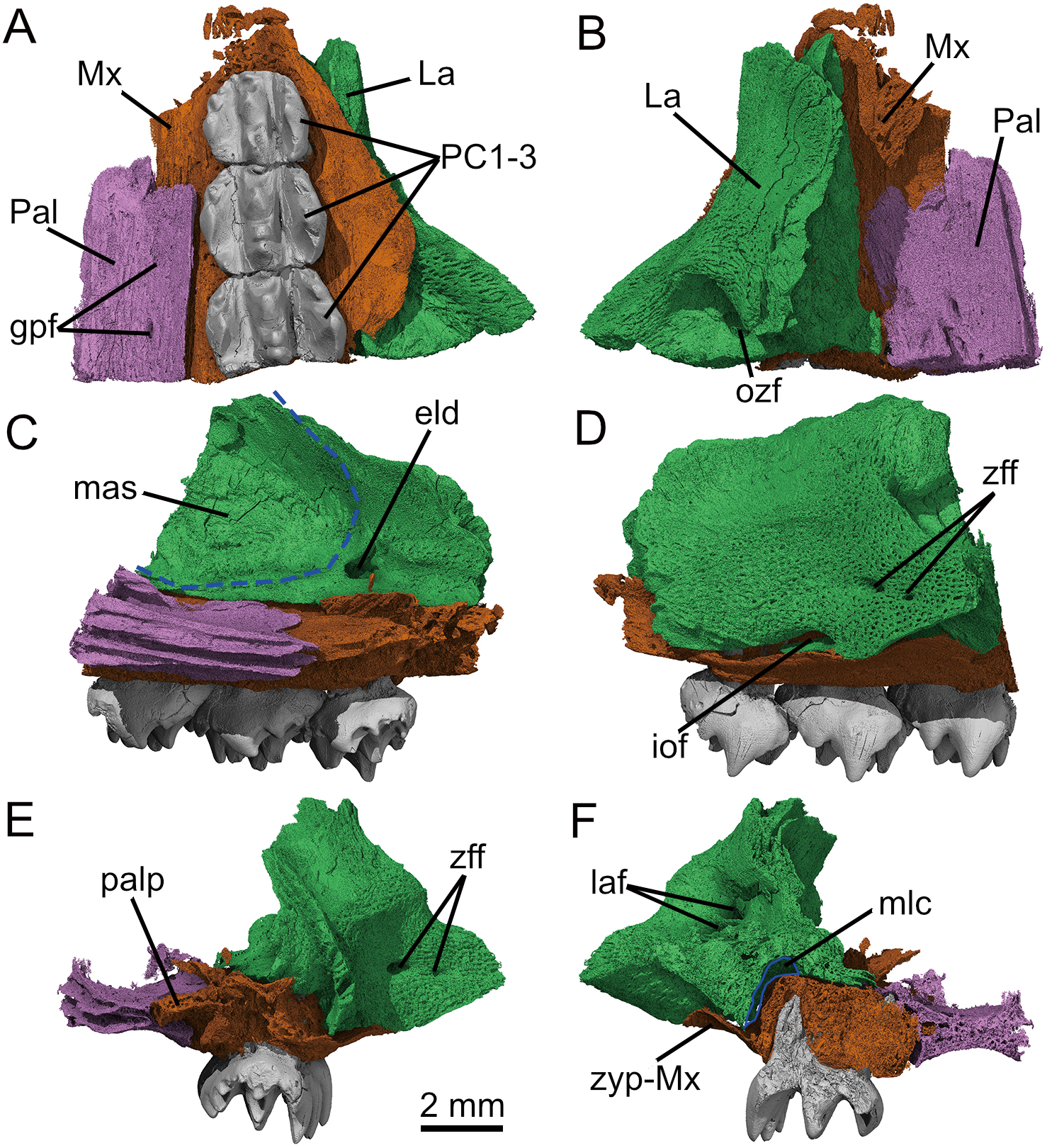
Fig. 2 CT-scan rendered images of Yuanotherium minor (IVPP V15335) with cranial elements segmented in different colors, in ventral (A), dorsal (B), medial (C), lateral (D), anterior (E), and posterior (F) views Abbreviations: eld. exit of the lacrimal duct; gpf. greater palatine foramen; iof. infraorbital foramen; La. lacrimal; laf. lacrimal foramen; mas. maxillary sinus; mlc. maxilla-lacrimal cavity; Mx. maxilla; ozf. orbital zygomaticofacial foramen; Pal. palatine; palp. palatal process of maxilla; zff. zygomaticofacial foramen; zyp-Mx. zygomatic process of maxilla
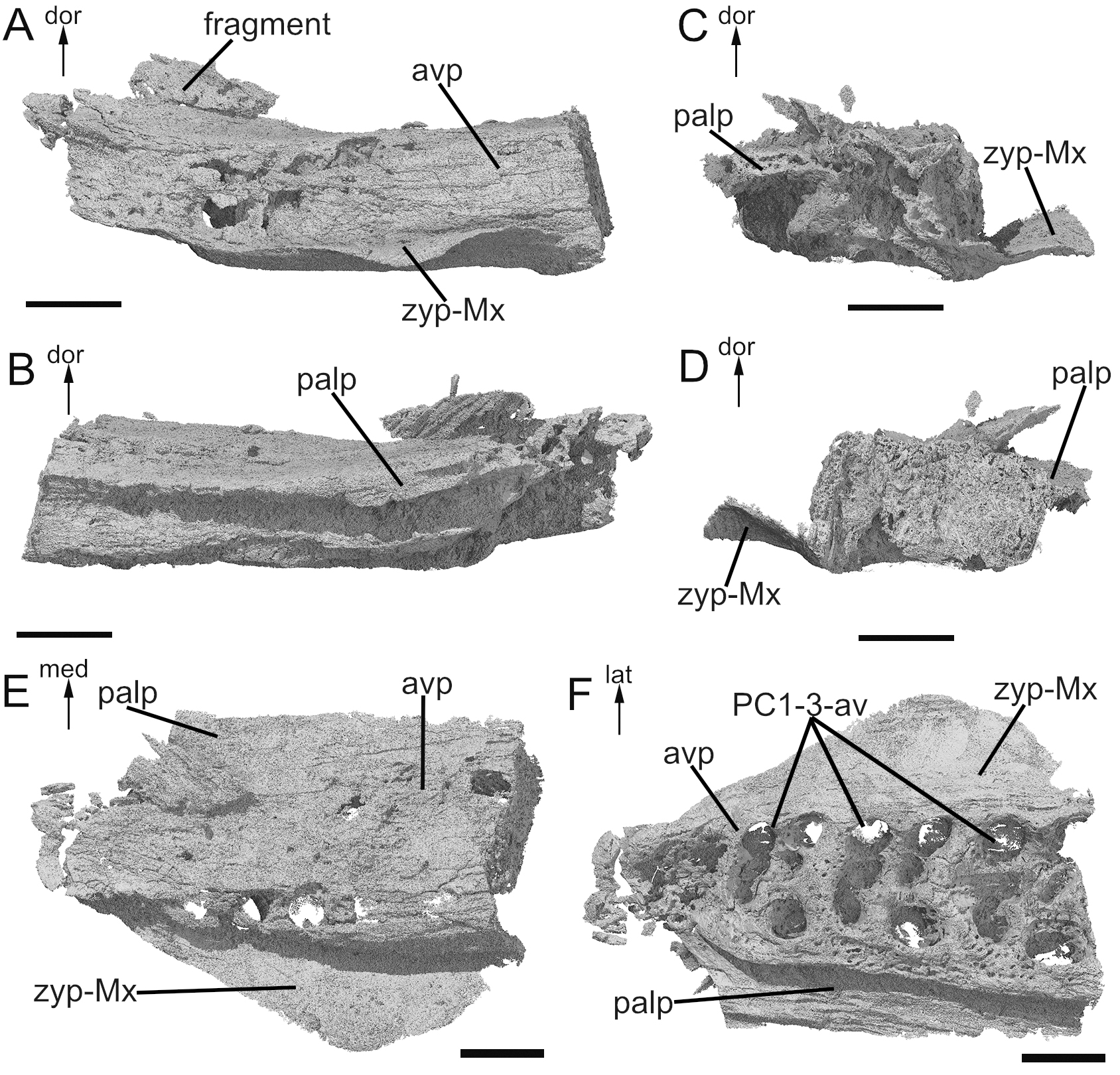
Fig. 3 The segmented left maxilla of Yuanotherium minor (IVPP V15335) in lateral (A), medial (B), anterior (C), posterior (D), dorsal (E), and ventral (F) views Abbreviations: avp. alveolar platform; palp. palatal process; PC1-3-av. alveolus for PC1-3; zyp-Mx. zygomatic process of maxilla. Scale bars=1.5 mm
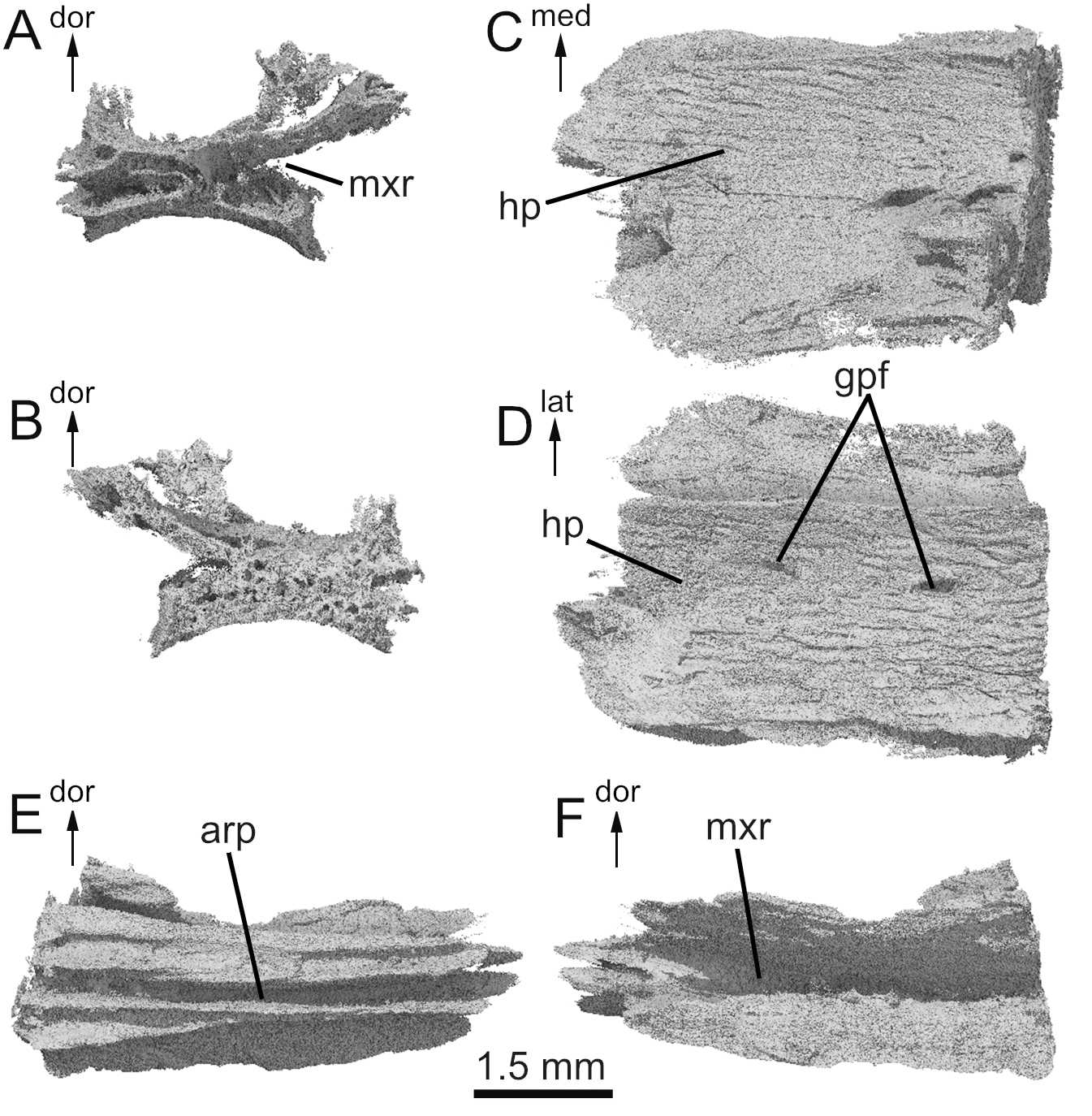
Fig. 4 The segmented palatine of Yuanotherium minor (IVPP V15335) in anterior (A), posterior (B), dorsal (C), ventral (D), medial (E), and lateral (F) views Abbreviations: arp. air passage within palatine; gpf. greater palatine foramen;hp. horizontal plate of palatine; mxr. maxillary recess of palatine
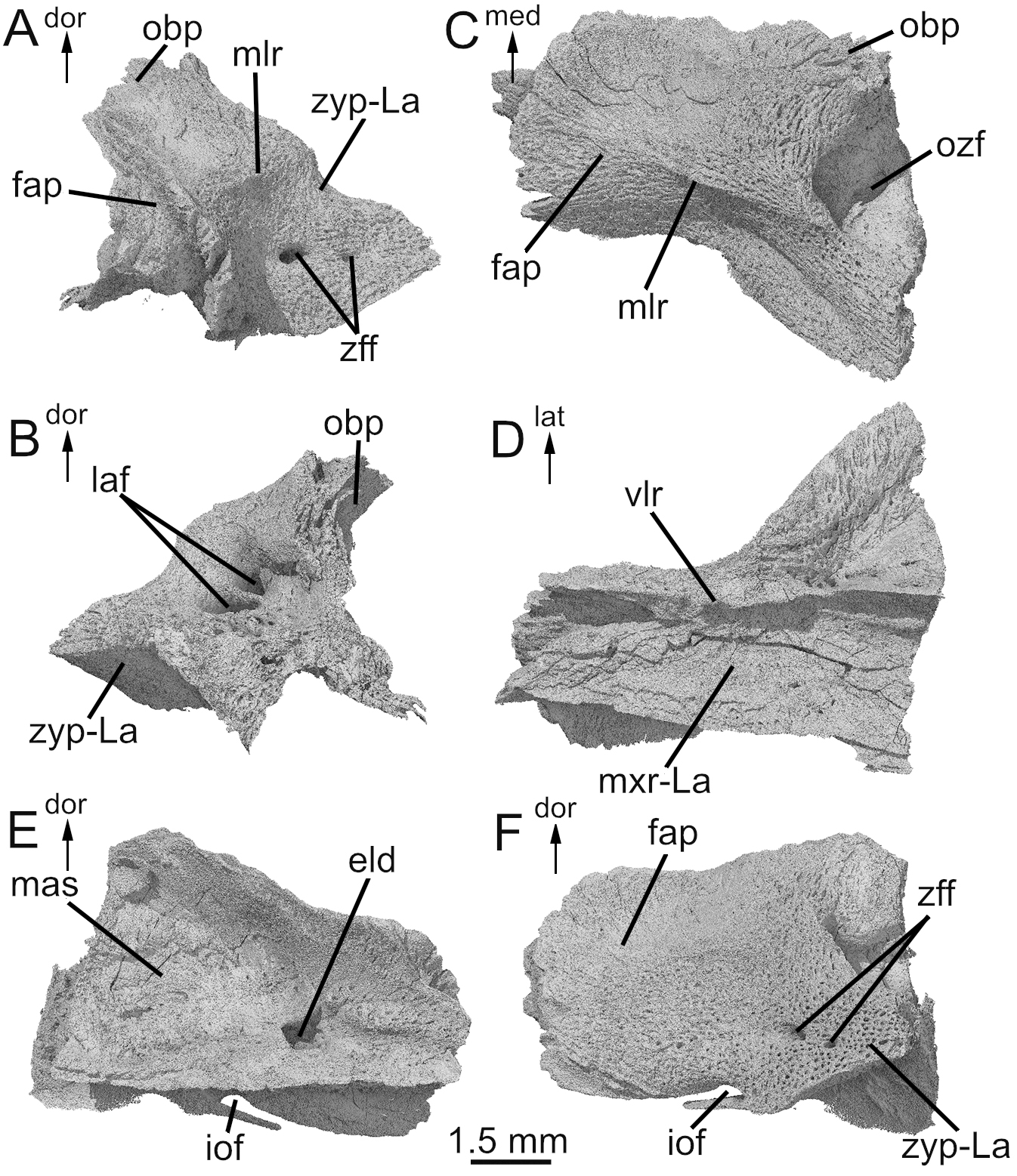
Fig. 5 The segmented lacrimal of Yuanotherium minor (IVPP V15335) in anterior (A), posterior (B), dorsal (C), ventral (D), medial (E), and lateral (F) views Abbreviations: eld. exit of lacrimal duct; fap. facial process of lacrimal; iof. infraorbital foramen; laf. lacrimal foramen; mas. maxillary sinus; mlr. middle lacrimal ridge; mxr-La. maxillary recess of lacrimal; obp. orbital process of lacrimal; ozf. orbital zygomaticofacial foramen; vlr. ventral ridge of lacrimal; zff. zygomaticofacial foramen; zyp-La. zygomatic process of lacrimal
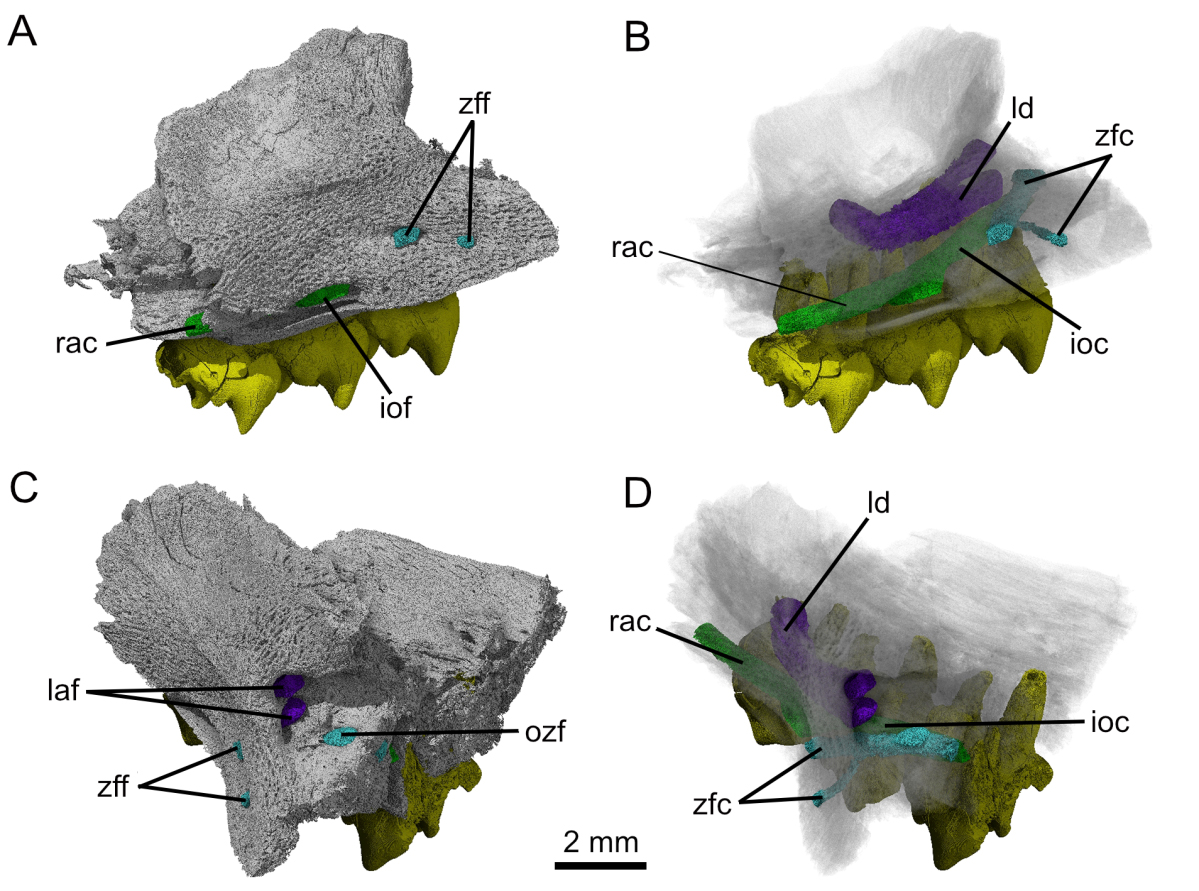
Fig. 6 Virtual 3D reconstruction of the maxillary canal system of Yuanotherium minor (IVPP V15335) in left oblique (A), transparent left oblique (B), left oblique orbital (C), and transparent left oblique orbital (D) views Abbreviations: ld. lacrimal duct; ioc. infraorbital canal; iof. infraorbital foramen; laf. lacrimal foramina; ozf. orbital zygomaticofacial foramen; rac. rostral alveolar canal; zfc. zygomaticofacial canal; zff. zygomaticofacial foramen
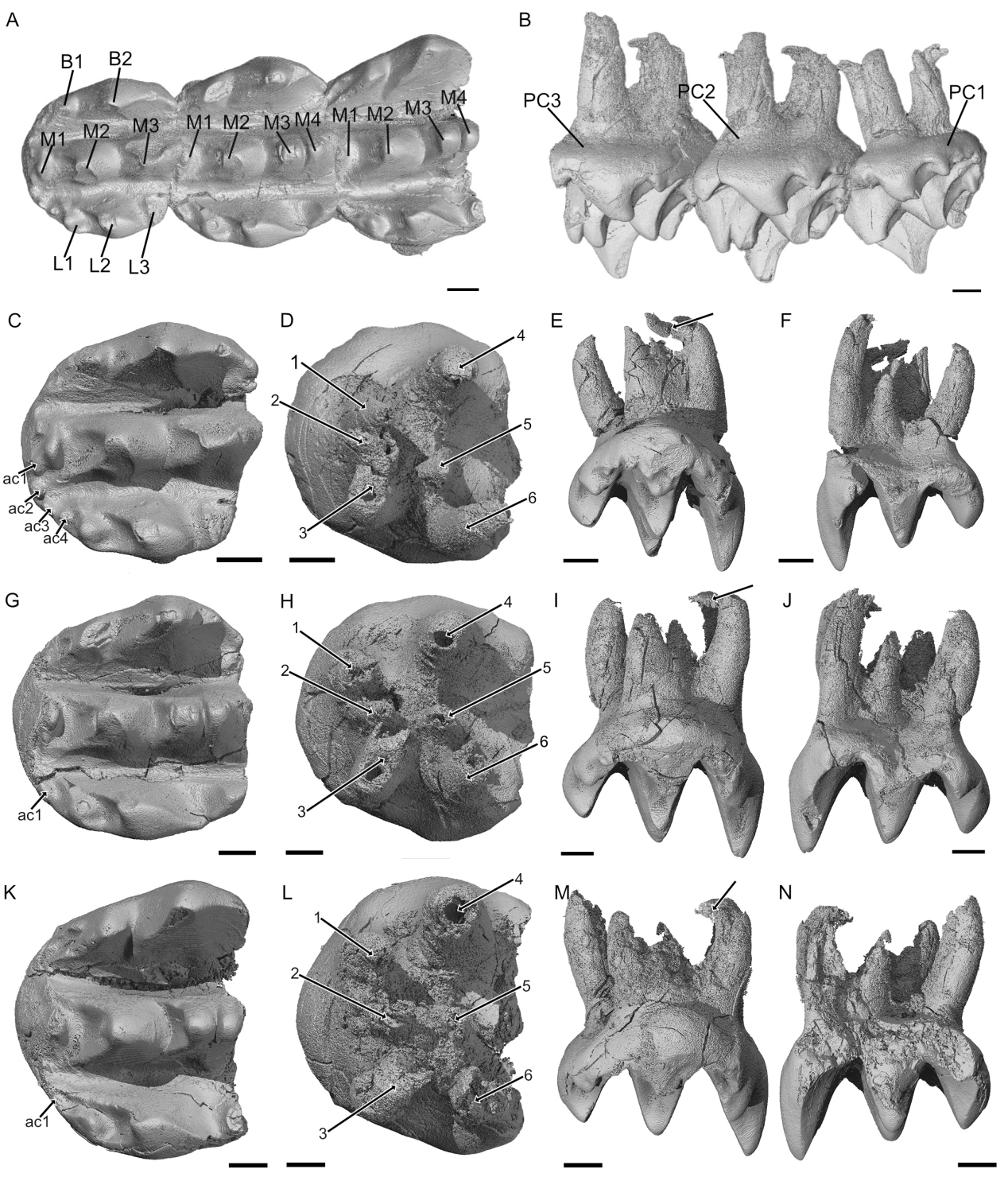
Fig. 7 The stereo-images of the three anterior postcanines of Yuanotherium minor (IVPP V15335) A, B. the three anterior postcanines in occlusal (A) and lingual (B) views; C-F. PC1 in occlusal (C), dorsal (D), anterior (E), and posterior (F) views; G-J. PC2 in occlusal (G), dorsal (H), anterior (I), and posterior (J) views; K-N. PC3 in occlusal (K), dorsal (L), anterior (M), and posterior (N) views Abbreviations: ac. accessory cuspules; B1. anterior cusp in the buccal row; B2. posterior cusp in the buccal row; L1, L2 and L3. anterior, median and posterior cusps in the lingual row, respectively; M1, M2, M3 and M4. anterior, median, posterior and the last cusps in the median row, respectively The numbers and arrows in D, H, L indicate the position of each root, whereas the arrows in E, I, M indicate the curvature in the anterior buccal root. Scale bars=0.5 mm

Fig. 8 The scanning electron microscope (SEM) photo of PC teeth of Yuanotherium minor (IVPP V15335), showing the wear facets and striations A. tooth row with the position of each zoom in B-H; B-H. close-up looking of the lingual cingulum of PC1 (B), the L2 cusp of PC1 (C), the lingual cingulum of PC2 (D), the M2 cusp of PC2 (E), the L3 + L4 cusps of PC2 (F), the lingual cingulum of PC3 (G), and the B2 cusp of PC3 (H) Blue arrows show the moving direction of the lower cusps when chewing, pink arrows show the major wear facets, red arrows show the position and direction of the wear scars on the functional cusps Note some abnormal dark areas on the photo are caused by glue
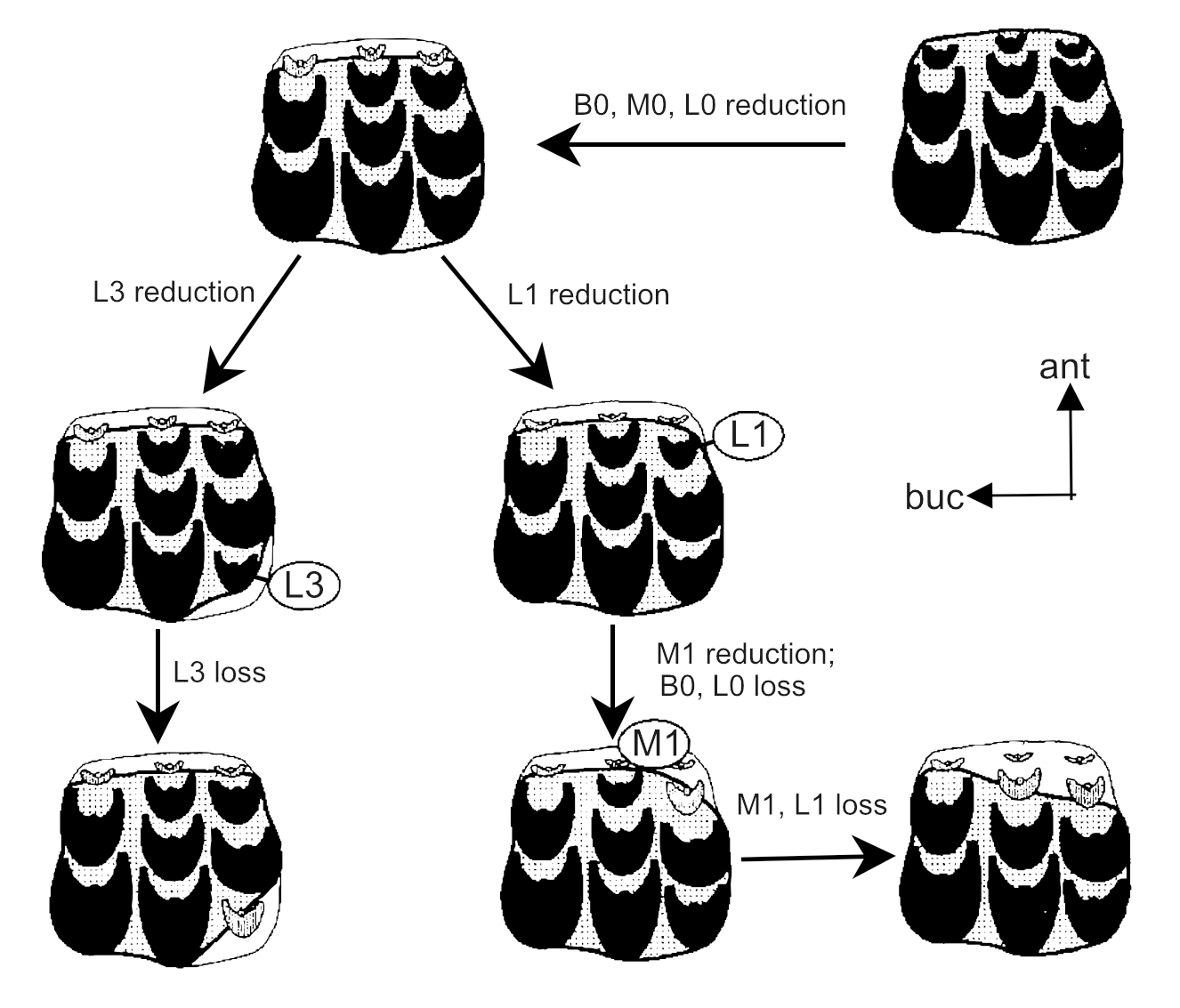
Fig. 9 Suggested cladogram of the Tritylodontidae based on the mode of reduction of the cusps of the upper postcanines Modified from Setoguchi et al. (1999). Figure not scaled
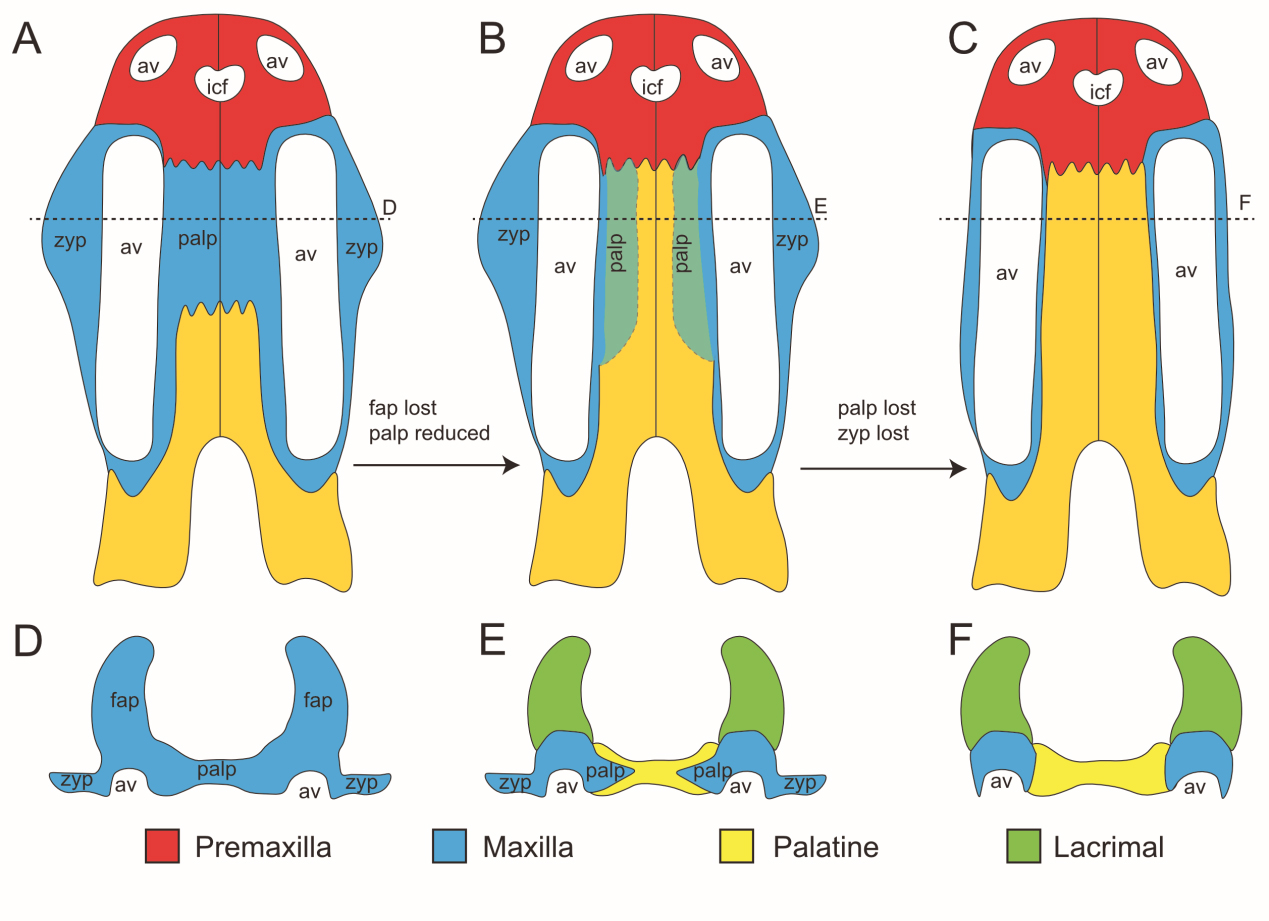
Fig. 10 Three patterns showing the maxillary evolution in tritylodontids A-C. diagrams showing ventral views of palatal elements of Kayentatherium, Yuanotherium, and Bienotheroides, respectively; D-F. cross sections corresponding to positions of D-F in A-C Abbreviations: av. alveolus; fap. facial process of maxilla; icf. incisive foramen; palp. palatal process of maxilla; zyp. zygomatic process of maxilla
| [1] | Augustin F J, Matzke A T, Maisch M W et al., 2021. Dinosaur taphonomy of the Jurassic Shishugou Formation (Northern Junggar Basin, NW China) - insights from bioerosional trace fossils on bone. Ichnos, 28(1): 1-10 |
| [2] | Averianov A O, Martin T, Lopatin A V et al., 2017. A tritylodontid synapsid from the Middle Jurassic of Siberia and the taxonomy of derived tritylodontids. J Vert Paleont, 37: e1363767 |
| [3] | Benoit J, Ruf I, Miyamae J A et al., 2020. The evolution of the maxillary canal in Probainognathia (Cynodontia, Synapsida): reassessment of the homology of the infraorbital foramen in mammalian ancestors. J Mamm Evol, 27: 329-348 |
| [4] | Choiniere J N, Clark J M, Forster C A et al., 2013. A juvenile specimen of a new coelurosaur (Dinosauria: Theropoda) from the Middle-Late Jurassic Shishugou Formation of Xinjiang, People’s Republic of China. J Syst Palaeontol, 12: 1-39 |
| [5] | Clark J M, Hopson J A, 1985. Distinctive mammal-like reptile from Mexico and its bearing on the phylogeny of the Tritylodontidae. Nature, 315: 398-400 |
| [6] | Crompton A W, 1972. Postcanine occlusion in cynodonts and tritylodonts. Bull Brit Mus Nat Hist (Geol), 21: 30-71 |
| [7] | Crompton A W, Ellenberger F, 1957. On a new cynodont from the Molteno Beds and the origin of tritylodontids. Ann S Afr Mus, 44: 1-14 |
| [8] | Currie P J, Zhao X J, 1993. A new carnosaur (Dinosauria, Theropoda) from the Jurassic of Xinjiang, People’s Republic of China. Can J Earth Sci, 30: 2037-2081 |
| [9] | Eberth D A, Xu X, Clark J M, 2010. Dinosaur death pits from the Jurassic of China. Palaios, 25: 112-125 |
| [10] | Fedak T J, Sues H D, Olsen P E, 2015. First record of the tritylodontid cynodont Oligokyphus and cynodont postcranial bones from the McCoy Brook Formation of Nova Scotia, Canada. Can J Earth Sci, 52: 244-249 |
| [11] | Hinz J K, Smith I, Pfretzschner H U et al., 2010. A high-resolution three-dimensional reconstruction of a fossil forest (Upper Jurassic Shishugou Formation, Junggar Basin, Northwest China). Palaeobio Palaeoenv, 90: 215-240 |
| [12] | Hopson J A, Kitching J W, 2001. A probainognathian cynodont from South Africa and the phylogeny of nonmammalian cynodonts. Bull Mus Comp Zool, 156: 5-35 |
| [13] | Hu Y M, Meng J, Clark J M, 2009. A new tritylodontid from the Upper Jurassic of Xinjiang, China. Acta Palaeontol Pol, 54: 385-391 |
| [14] | Kemp T S, 1983. The relationships of mammals. Zool J Linn Soc Lond, 77: 353-384 |
| [15] | Kemp T S, 2005. The Origin and Evolution of Mammals. New York: Oxford University Press. 1-344 |
| [16] | Kerber L, Montoya-Sanhueza G, Roese-Miron L et al., 2025. New insights into the postcranial anatomy of Exaeretodon riograndensis (Eucynodontia:Traversodontidae): phylogenetic implications, body mass, and lifestyle. J Mamm Evol, 32: 2 |
| [17] | Kermack D M, 1982. A new tritylodontid from the Kayenta formation of Arizona. Zool J Linn Soc Lond, 76: 1-17 |
| [18] | Kühne W G, 1956. The Liassic Therapsid Oligokyphus. London: British Museum (Natural History). 1-149 |
| [19] | Liu J, Olsen P, 2010. The phylogenetic relationships of Eucynodontia (Amniota: Synapsida). J Mamm Evol, 17: 151-176 |
| [20] | Liu J W, Wang L H, Beatty B L et al., 2023. New material (Tritylodontidae, Mammaliamorpha) from the Lower Jurassic of Lufeng and its implication on the taxonomy of Lufengia. Hist Biol, 35(9): 1606-1615 |
| [21] | Liu J W, Xu X, Clark J M et al., 2025. Bienotheroides wucaiensis sp. nov., a new tritylodontid (Cynodontia, Mammaliamorpha) from the Late Jurassic Shishugou Formation of Xinjiang, China. Anat Rec, 308: 1-35 |
| [22] | Liu L, Zhou C F, Wang J S, 2023. A new tritylodontid from the Middle Jurassic Shaximiao Formation of western Hubei, China. Hist Biol, 35(8): 1391-1400 |
| [23] | Liu L, Wei G B, Wang P et al., 2025. New discovery of tritylodontids from the Milldle Jurassic Yunyang area, Chongqing and their paleogeographic significance. J Palaeogeog, 27(2): 484-498 |
| [24] | Maisch M W, Matzke A T, Sun G, 2004. A new tritylodontid from the Upper Jurassic Shishugou Formation of the Junggar Basin (Xinjiang, NW China). J Vert Paleont, 24: 649-656 |
| [25] | Mao F Y, Zhang C, Liu C Y et al., 2021. Fossoriality and evolutionary development in two Cretaceous mammaliamorphs. Nature, 592: 577-582 |
| [26] | Matsuoka H, Kusuhashi N, Corfe I J, 2016. A new Early Cretaceous tritylodontid (Synapsida, Cynodontia, Mammalia-morpha) from the Kuwajima Formation (Tetori Group) of central Japan. J Vert Paleont, 36: e1112289 |
| [27] | Owen R, 1884. On the skull and dentition of a Triassic mammal (Tritylodon longaevus) from South Africa. Q J Geol Soc, 40: 146-152 |
| [28] | Panciroli E, Walsh S, Fraser N C et al., 2017. A reassessment of the postcanine dentition and systematics of the tritylodontid Stereognathus (Cynodontia, Tritylodontidae, Mammaliamorpha), from the Middle Jurassic of the United Kingdom. J Vert Paleont, 37: e1351448 |
| [29] | Rowe T, 1988. Definition, diagnosis, and origin of Mammalia. J Vert Paleont, 8: 241-264 |
| [30] | Ruta M, Botha-Brink J, Mitchell S A et al., 2013. The radiation of cynodonts and the ground plan of mammalian morphological diversity. Proc R Soc B, 280: 20131865 |
| [31] | Setoguchi T, Matsuda M, Matsuoka H, 1999. New discovery of an Early Cretaceous tritylodontid (Reptilia, Therapsida) from Japan and the phylogenetic reconstruction of Tritylodontidae based on the dental characters. In: Wang Y Q, Deng T eds. Seventh Annual Meeting of the Chinese Society of Vertebrate Paleontology. Beijing: China Ocean Press. 117-124 |
| [32] | Simpson G G, 1928. A Catalogue of the Mesozoic Mammalia in the Geological Department of the British Museum. London: Trustees of the British Museum. 1-215 |
| [33] | Stefanello M, Martinelli A G, Muller R T, 2023. A complete skull of a stem mammal from the Late Triassic of Brazil illuminates the early evolution of prozostrodontian cynodonts. J Mamm Evol, 30: 299-317 |
| [34] | Sues H D, 1985. The relationship of the Tritylodontidae (Synapsida). Zool J Linn Soc Lond, 85: 205-217 |
| [35] | Sues H D, 1986. The skull and dentition of two tritylodontid synapsids from the Lower Jurassic of western North America. Bull Mus Comp Zool, 151: 217-268 |
| [36] | Sun A L, 1984. Skull morphology of the tritylodont genus Bienotheroides of Sichuan. Sci Sin B, 27: 970-984 |
| [37] | Tatarinov L P, Maschenko E N, 1999. A find of an aberrant tritylodont (Reptilia, Cynodontia) in the Lower Cretaceous of the Kemerovo Region. Paleontol J, 33: 422-428 |
| [38] | Velazco P M, Buczek A J, Novacek M J, 2017. Two new tritylodontids (Synapsida, Cynodontia, Mammaliamorpha) from the Upper Jurassic, southwestern Mongolia. Am Mus Novit, 3874: 1-35 |
| [39] | Wang Y F, Wei C F, Que J M et al., 2019. Development and applications of paleontological computed tomography. Vert PalAsiat, 57: 84-92 |
| [40] | Watabe M, Tsubamoto T, Tsogtbaatar K, 2007. A new tritylodontid synapsid from Mongolia. Acta Palaeontol Pol, 52: 263-274 |
| [41] | Wible J R, 2003. On the cranial osteology of the short-tailed opossum Monodelphis brevicaudata (Didelphidae, Marsupialia). Ann Carnegie Mus, 72: 137-202 |
| [42] | Young C C, 1947. Mammal-like reptiles from Lufeng, Yunnan, China. Proc Zool Soc Lond, 117: 537-597 |
| Viewed | ||||||
|
Full text |
|
|||||
|
Abstract |
|
|||||